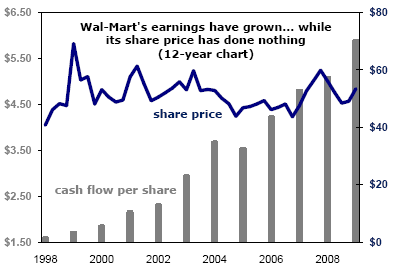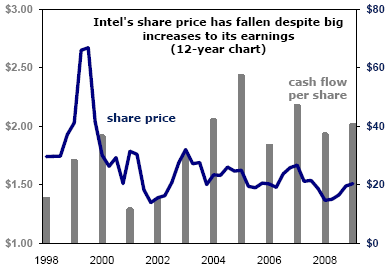| Home | About Us | Resources | Archive | Free Reports | Market Window |
Why You Should Begin Buying the World's Safest StocksBy
Saturday, July 17, 2010
This month, I faced one of the most difficult choices of my career as an investment analyst.
If you've been reading my Investment Advisory or DailyWealth for more than a month, you probably know I'm concerned with exploding levels of government debt in Europe and the United States. Western governments have taken on obligations they cannot possibly hope to repay. The outcome will be a severe devaluation of their paper currencies. You can read some of my thoughts on this subject here and here.
Now, this is where it gets difficult...
Despite all of the world's credit and currency problems, many of the market's highest-quality companies are once again trading for extremely attractive prices, thanks to the fall in stock prices during the second quarter.
The question that's keeping me up at night isn't whether or not the currency crisis we're experiencing will worsen. I know it will. What keeps me up at night now is wondering whether or not by focusing so much on the risks, I could be missing the opportunities this crisis has created.
You see, despite the huge risks to the global economy, I know it's unlikely that everything will grind to a complete halt or that a new, global war will break out. Having been a leader in warning about the impending sovereign debt crisis, I'm now trying to lead my readers in a new direction – the incredible value presenting itself in the form of the world's biggest global companies.
We begin with a conclusion you might find surprising: Only rarely in history have the world's largest and best corporations been for sale at lower prices. Furthermore, buying blue-chip stocks at these super-low valuations has historically always led to outstanding returns. In short, high-quality stocks are amazingly cheap. And you're probably foolish if you don't at least start to buy.
The chart below shows you the share price of Wal-Mart – the world's leading retailer – compared to its earnings.
 As you can plainly see, over the last 12 years, the stock price of Wal-Mart has done exactly nothing. Meanwhile, its earnings have continued to grow, almost every single year, by large amounts.
Wal-Mart is now earning more than $26 billion annually in cash. It is returning roughly $12 billion to shareholders (via dividends and buybacks) and spending $12 billion building new stores or improving old ones. The remaining balance of its cash earnings is going toward repaying debt – almost $2 billion was retired last year.
And yet... the company's entire market value is now $190 billion. That is, if Wal-Mart applied all of its capital toward buying stock, it could take itself private in a little over seven years – assuming no additional growth whatsoever. Given its recent growth rates, it could likely accomplish this goal in something around five years.
A reasonable analyst, adjusting for Wal-Mart's unique resilience and long history of earnings growth, would assign the company a forward earnings multiple of something between five and seven. Meanwhile the stock is currently yielding more than 6%, when you adjust the cash dividends for the share buybacks. In short, Wal-Mart now has an earnings multiple that's roughly the same number as its yield, a situation that is extremely rare in the world's highest-quality stocks.
At the bottom of the stock market in 1932, the S&P 500 traded for less than 10 times earnings and yielded roughly 10%. At the bottom of the market in 1974, the S&P 500 traded at seven or eight times earnings and was yielding nearly that much in income (6.5%). And at the market bottom in 1982, stocks were again trading for around six times earnings, while the dividend yield had increased to almost 7%.
In short, Wal-Mart's valuation suggests we are approaching a bottom in high-quality stocks. While this isn't true – yet – for the market as a whole (today the S&P 500 yields just over 2% in cash and is trading at 17 times earnings), it is true of the market's best companies.
Take a look at Intel, for another example.
 Intel's growth isn't as uniform as Wal-Mart's. But its share price has actually fallen substantially over the last 12 years, despite big increases to its earnings. Intel's CEO, Paul Otellini, said the most recent quarter was the best in Intel's entire history, with revenue of $10.8 billion – up 34% from last year's second quarter. And yet, despite these record results, Intel's stock price remains near $20 – down from $70 in the late 1990s. Let me show you what that means in terms of current valuation...
I expect Intel will earn something around $15 billion this year in cash. After spending roughly $4 billion building new factories and expanding old ones, Intel will have $11 billion left over for debt repayment and distributions. Given that it only holds $2 billion in debt, I doubt any of this cash will go toward debt repayment. But to be conservative, let's assume Intel decides to repay half of its debt. That implies it will return something around $10 billion to shareholders. (These aren't pie-in-the-sky figures. In 2008, Intel returned more than $9 billion to shareholders.)
Given Intel's $100 billion market value, my forecast is Intel will yield something around 10% to equity investors this year, including both cash dividends and stock buybacks. Meanwhile, the company is trading at a cash-earnings multiple of less than seven.
I can't stress enough how unusual it is for super-high-quality stocks to be paying dividend yields that are actually bigger than their earnings multiple. Opportunities to buy stocks at such low prices only occur around market bottoms.
The point, as I'm sure you've gotten by now, is that these companies, which represent some of the finest examples of capitalism in the world, are trading at silly cheap prices. And while I have very real concerns about the well-being of the global economy, I believe these firms will be far more able to weather the coming storm than just about any other kind of asset.
Here we are, 12 years after the peak of stock valuations. All of the best companies, which people were paying crazy prices to own in their 401k accounts back then, have executed either as well – or better – than any reasonable projection would have forecast. The companies earned the money they were expected to earn – sometimes more. And yet today, with these companies vastly richer, better managed, and in better competitive positions, suddenly investors don't want them anymore.
While I don't believe the stock market in general is a good buy, I do believe now is the time to buy these incredible businesses nobody else wants.
Good investing,
Further Reading:
Our own Dan Ferris has been whistling the cheap-blue-chip tune for two years now... And like Porter, he's worried about the high valuation of the market in general. If you're thinking about taking the "easy" route to bet on a rally, don't miss his recent essay: Why You're Crazy to Buy an Index Fund Right Now.
Porter says buying blue chips today is the right bet. But you can't just rely on high-quality stocks to keep your money safe. Find the one move you should make to protect your wealth here: The Single Most Important Financial Step You Can Take Right Now.
Market NotesCHART OF THE WEEK: A LOOK AT OUR TOP ECONOMIC INDICATOR Our chart of the week is our old friend Dr. Copper. This week, he's saying, "Things aren't so bad."
You see, one of the great debates in the investment community right now is whether the global economic recovery "has legs." On one side, you have the optimists, who say the recovery is real and we're doing just fine, don't worry so much. On the other side, you have the pessimists, who say the recovery is a short-term goosing based on cheap credit... and the bear market of 2008 will resume within a year, go ahead and worry and invest accordingly.
One way to monitor this argument is by watching the price of copper. Copper is in nearly everything around you... from cars and plumbing to electronics and power lines. This "in everything" attribute makes the metal rise and fall with economic activity.
|
Stat of the week
3.4%
Amount Goldman Sachs' landmark SEC fine this week represents as a percentage of the company's 2009 employee bonus pool, which was $16.2 billion. In The Daily Crux
Recent Articles
|

